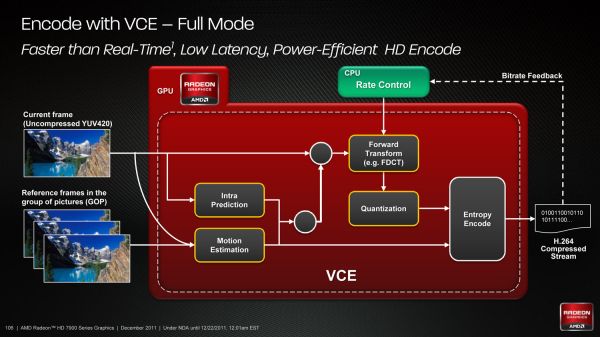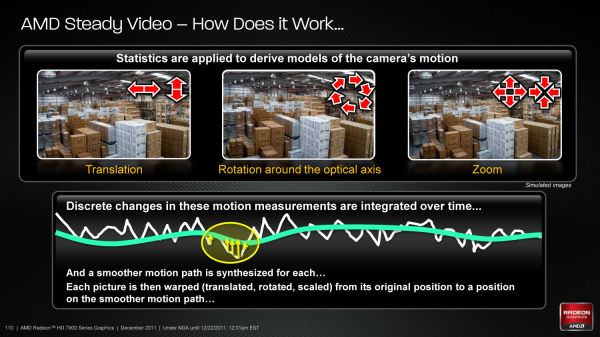AMD Radeon HD 7970 Review: 28nm And Graphics Core Next, Together As One
by Ryan Smith on December 22, 2011 12:00 AM EST- Posted in
- GPUs
- AMD
- Radeon
- ATI
- Radeon HD 7000
Video & Movies: The Video Codec Engine, UVD3, & Steady Video 2.0
When Intel introduced the Sandy Bridge architecture one of their big additions was Quick Sync, their name for their hardware H.264 encoder. By combining a specialized fixed function encoder with some GPU-based processing Intel was able to create a small, highly efficient H.264 encoder that had quality that was as good as or better than AMD and NVIDIA’s GPU based encoders that at the same time was 2x to 4x faster and consumed a fraction of the power. Quick Sync made real-time H.264 encoding practical on even low-power devices, and made GPU encoding redundant at the time. AMD of course isn’t one to sit idle, and they have been hard at work at their own implementation of that technology: the Video Codec Engine (VCE).
The introduction of VCE brings up a very interesting point for discussing the organization of AMD. As both a CPU and a GPU company the line between the two divisions and their technologies often blurs, and Fusion has practically made this mandatory. When AMD wants to implement a feature, is it a GPU feature, a CPU feature, or perhaps it’s both? Intel implemented Quick Sync as a CPU company, but does that mean hardware H.264 encoders are a CPU feature? AMD says no. Hardware H.264 encoders are a GPU feature.
As such VCE is being added to the mix from the GPU side, meaning it shows up first here on the Southern Islands series. Fundamentally VCE is very similar to Quick Sync – it’s based on what you can accomplish with the addition of a fixed function encoder – but AMD takes the concept much further to take full advantage of what the compute side of GCN can do. In “Full Mode” VCE behaves exactly like Quick Sync, in which virtually every step of the H.264 encoding process is handled by fixed function hardware. Just like Quick Sync Full Mode is fast and energy efficient. But it doesn’t make significant use of the rest of the GPU.
Hybrid Mode is where AMD takes things a step further, by throwing the compute resources of the GPU back into the mix. In Hybrid Mode only Entropy Encode is handled by fixed function hardware (this being a highly serial process that was ill suited to a GPU) with all the other steps being handled by the flexible hardware of the GPU. The end goal of Hybrid Mode is that as these other steps are well suited to being done on a GPU, Hybrid Mode will be much faster than even the highly optimized fixed function hardware of Full Mode. Full Mode is already faster than real time – Hybrid Mode should be faster yet.
With VCE AMD is also targeting Quick Sync’s weaknesses regardless of the mode used. Quick Sync has limited tuning capabilities which impacts the quality of the resulting encode. AMD is going to offer more tuning capabilities to allow for a wider range of compression quality. We don’t expect that it will be up to the quality standards of X264 and other pure-software encoders that can generate archival quality encodes, but if AMD is right it should be closer to archival quality than Quick Sync was.
The catch right now is that VCE is so new that we can’t test it. The hardware is there and we’re told it works, but the software support for it is lacking as none of AMD’s partners have added support for it yet. On the positive side this means we’ll be able to test it in-depth once the software is ready as opposed to quickly testing it in time for this review, however the downside is that we cannot comment on the speed or quality at this time. Though with the 7970 not launching until next year, there’s time for software support to be worked out before the first Southern Islands card ever goes on sale.
Moving on, while encoding has been significantly overhauled decoding will remain largely the same. AMD doesn’t refer to the Universal Video Decoder on Tahiti as UVD3, but the specifications match UVD3 as we’ve seen on Cayman so we believe it to be the same decoder. The quality may have been slightly improved as AMD is telling us they’ve scored 200 on HQV 2.0 – the last time we scored them they were at 197 – but HQV is a partially subjective benchmark.
Finally, with Southern Islands AMD is introducing Steady Video 2.0, thesuccessor to Steady Video that was introduced with the Llano APU last year. Steady Video 2.0 adds support for interlaced and letter/pillar boxed content, along with a general increase in the effectiveness of the steadying effect. What makes this particularly interesting is that Steady Video implements a new GCN architecture instruction, Quad Sum of Absolute Differences (QSAD), which combines regular SAD operations with alignment operations into a single instruction. As a result AMD can now execute SADs at a much higher rate so long as they can be organized into QSADs, which is one of the principle reasons that AMD was able to improve Steady Video as it’s a SAD-heavy operation. QSAD extends to more than just Steady Video (AMD noted that it’s also good for other image analysis operations), but Steady Video is going to be the premiere use for it.












292 Comments
View All Comments
gevorg - Thursday, December 22, 2011 - link
37.9dB is a horrible testbed for noise testing! WTF!mavere - Thursday, December 22, 2011 - link
Seriously!With the prevalence of practically silent PSUs, efficient tower heatsinks, and large quiet fans, I cannot fathom why the noise floor is 37.9 dB.
Finally - Thursday, December 22, 2011 - link
As usual, AT is shooting straight for the brain-dam, I mean, ENTHUSIAST crowd feat. a non-mentioned power supply that should be well around 1000W in order to drive over-priced CPUs as well as quadruple GPU setups.If you find that horrendous they will offer you not to read this review, but their upcoming HTPC review where they will employ the same 1000W power supply...
B3an - Thursday, December 22, 2011 - link
*face palm*1: 1000+ Watt PSU's are normally more quiet if anything as they're better equipped to deal with higher power loads. When a system like this uses nowhere near the PSU's full power the fan often spins at a very low RPM. Some 1000+ PSU's will just shut the fan off completely when a system uses less than 30% of it's power.
2: It's totally normal for a system to be around 40 dB without including the graphics cards. Two or 3 fans alone normally cause this much noise even if they're large low RPM fans. Then you have noise levels from surroundings which even in a "quiet" room are normally more than 15 dB.
3: Grow some fucking brain cells kids.
andymcca - Thursday, December 22, 2011 - link
1) If you were a quiet computing enthusiast, you would know that the statement"1000+ Watt PSU's are normally more quiet if anything"
is patently false. 1000W PSUs are necessarily less efficient at realistic loads (<600W at full load in single GPU systems). This is a trade-off of optimizing for efficiency at high wattages. There is no free lunch in power electronics. Lower efficiency yields more heat yields more noise, all else being equal. And I assure you that a high end silent/quiet PSU is designed for low air flow and uses components at least as high in quality as their higher wattage (non-silent/non-quiet) competitors. Since the PSU is not decribed (a problem which has been brought up many times in the past concerning AT reviews), who knows?
2) 40dB is fairly loud if you are aiming for quiet operation. Ambient noise in a quiet room can be roughly 20dB (provided there is not a lot of ambient outdoor noise). 40dB is roughly the amplitude of conversation in a quiet room (non-whispered). A computer that hums as loud as I talk is pretty loud! I'm not sure if you opinion is informed by any empirical experience, but for precise comparison of different sources the floor should be at minimum 20dB below the sources in question.
3) You have no idea what the parent's age or background is, but your comment #3 certainly implies something about your maturity.
formulav8 - Tuesday, February 21, 2012 - link
Seriously grow up. Your a nasty mouth as well.piroroadkill - Thursday, December 22, 2011 - link
Haha, yeah.Still, I guess we have to leave that work to SPCR.
Kjella - Thursday, December 22, 2011 - link
High-end graphics cards are even noisier, so who cares? A 250W card won't be quiet no matter what. Using an overclocked Intel Core i7 3960X is obviously so the benchmarks won't be CPU limited, not to make a quiet PC.Ryan Smith - Thursday, December 22, 2011 - link
Our testing methodology only has us inches from the case (an open case I should add), hence the noise from our H100 closed loop radiator makes itself known. In any case these numbers aren't meant to be absolutes, we only use them on a relative basis.MadMan007 - Thursday, December 22, 2011 - link
[AES chart] on page 7?